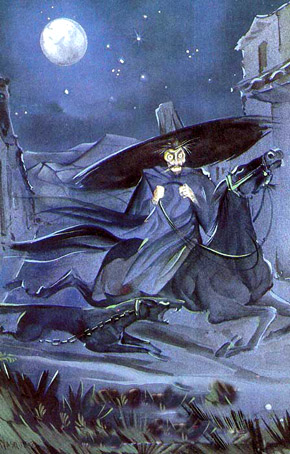Legend Has It: El Sombrerón
Welcome back to the Morbid Library. It’s been a while, readers, but we’re returning with an all new set of posts for Hispanic Heritage month – which runs from September 15 to October 15. We’ll discuss a few unidentified descendants, missing persons, urban legends, and cryptids. First up: a Boogeyman myth known as El Sombrerón.
The Legend
The main story of El Sombrerón centers around a young woman named Susana. Susana lived in La Recolección – which appears to be a former monastery in Antigua, Guatemala. She was described as incredibly beautiful with long, dark hair and large eyes. One summer night at dusk, she was out on her balcony watching the stars when she noticed a short man dressed in all black. He also wore a black sombrero and carried a silver guitar.
He stopped beneath her balcony and began to play that guitar and sing up to where Susana stood on the balcony. She began to fall under some sort of spell, which was broken when her mother called out to her. The man vanished, but did not stay gone. He began to appear before Susana everywhere she went, and she could not stop thinking of him. Every time she ate, she found soil in her food. She could not eat, lost weight, and her mental health suffered. Eventually, her mother chopped her beautiful long hair off. They went to the church, where the hair was soaked in holy water and prayed over by a priest. Susana never saw El Sombrerón again.
Features
While there are many different versions of the El Sombrerón legend from around the world – he appears in Guatemala, Mexico, Columbia, and other countries – the stories have many similarities across the board. El Sombrerón wears all black in all of the variations of the legend that I read, though his shoes do vary in color. He is always very short, which lends to his other nickname: the Goblin. Other constants include the use of that silver guitar to lure his target into a hypnotized state so he is able to kidnap them. He is most obsessed with women with long hair and large eyes (hence Susana).
It is said that he travels with mules and will braid their manes and tails. If he encounters other hair – such as a horse or dog – he braids that as well. He is said to only enter town at dusk. Once he chooses his target, he ties his pack of mules up at or near her homes, marking her. Once he snatches her up, he takes her back to his home and has her eat dirt. Once the dirt is ingested, the woman is unable to sleep or eat.

via The Foodies’ Kitchen)
Encounters
There are a handful of stories of personal encounters with El Sombrerón across the web, and those who speak up about coming face-to-face with him are still scared to speak about their experience to this day. One such person recounted how she saw him when she was a young child, and still felt fear relaying the tale. Online comments share family stories as well – of uncles seeing El Sombrerón saunter by paying them no mind, of seeing El Sombrerón moving through far-off shadows, of young women being told to keep their hair in braids lest El Sombrerón get them. There are far less encounters out there than for other urban legends and folklore we’ve examined, though that’s possible due to the cultural barrier.
Analysis
I was unable to find a concrete starting point for this legend, but some researchers posit that El Sombrerón may have roots all the way back to Mayan culture, as such a significance is placed on braids and long hair. Others suggest that he’s just a tall tale used to encourage safe habits within young women – not wandering alone in the night, not engaging with strange men, not falling for the romantic tricks of scoundrels.
The story of El Sombrerón is seemingly a typical Boogeyman story. It warns young women to be wary of men who speak to them at night – especially those men that use flashy tricks (such as music) to lull them into a false sense of security. The fact that El Sombrerón wears such a large hat and all black also hints at a need for concealment, which serves as a warning to women (again, this legend is a warning to women specifically) to be wary of men who hide themselves and their true intentions.
Black is also a color that typically does not have positive connotations. Beyond its functionality to assist El Sombrerón in slipping between shadows at dusk, I don’t think it is too much of a stretch to point out that black often symbolizes the underworld or bad luck as well. And, as a Boogeyman, El Sombrerón represents Things That Go Bump in the Night – murderous men and dangerous demons alike.
Sources
- https://remezcla.com/culture/el-sombreron-que-horror-halloween-guatemala/
- https://mexicodailypost.com/2021/10/23/el-hombre-del-sombreron-the-horror-legend-born-in-chiapas/
- http://folklore.usc.edu/el-sombreron-colombia/
- https://quepasa.gt/legends-guatemala-tradition/
- https://www.colombia.co/en/colombia-country/colombias-myths-legends/
- https://www.artic.edu/artworks/199521/the-mask-of-the-sombreron-illustration-for-el-sombreron
- http://www.allthingsguatemala.com/5-interesting-guatemalan-legends/
- https://www.spanglishvoces.com/index.php/2020/10/24/el-susto/
- https://www.reddit.com/r/Thetruthishere/comments/j2816w/el_sombrer%C3%B3n_looking_for_people_who_grew_up/

Wow!…..My aunt (Dad’s sister) was the very first Latina LAPD officer and told us stories that citizens had reported in Los Angeles, in particular in the Echo Park, MacArthur Park and Griffith Park areas.